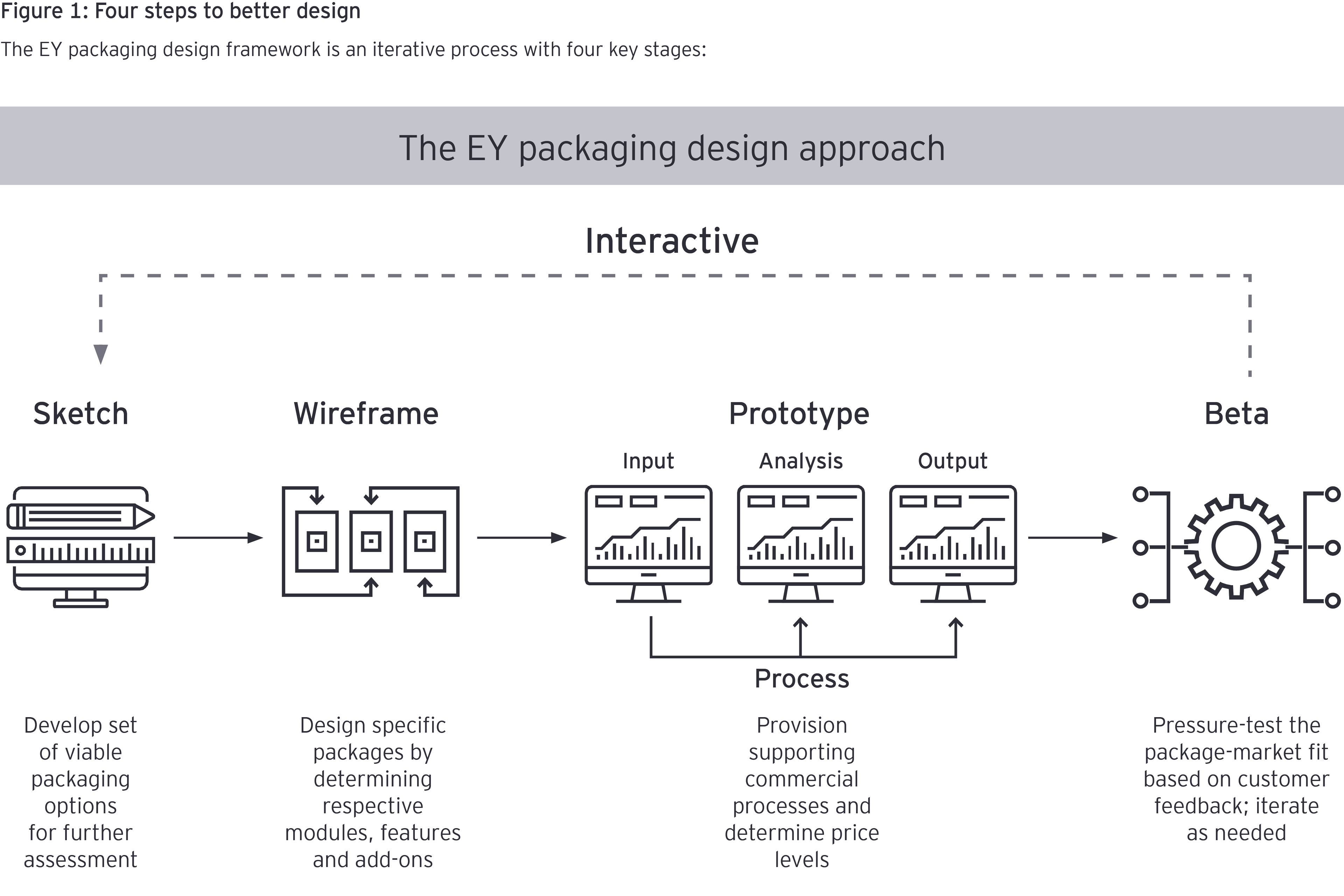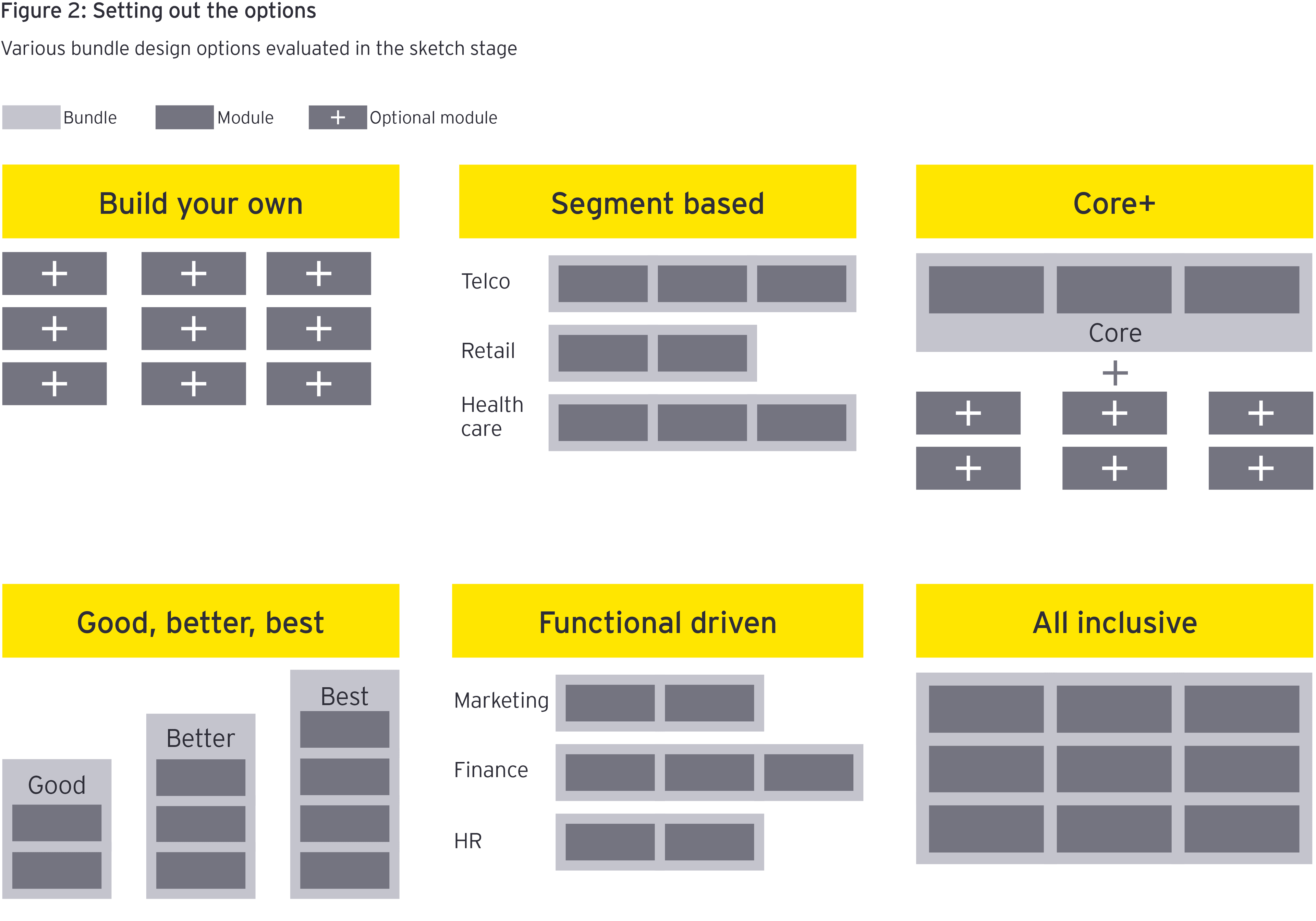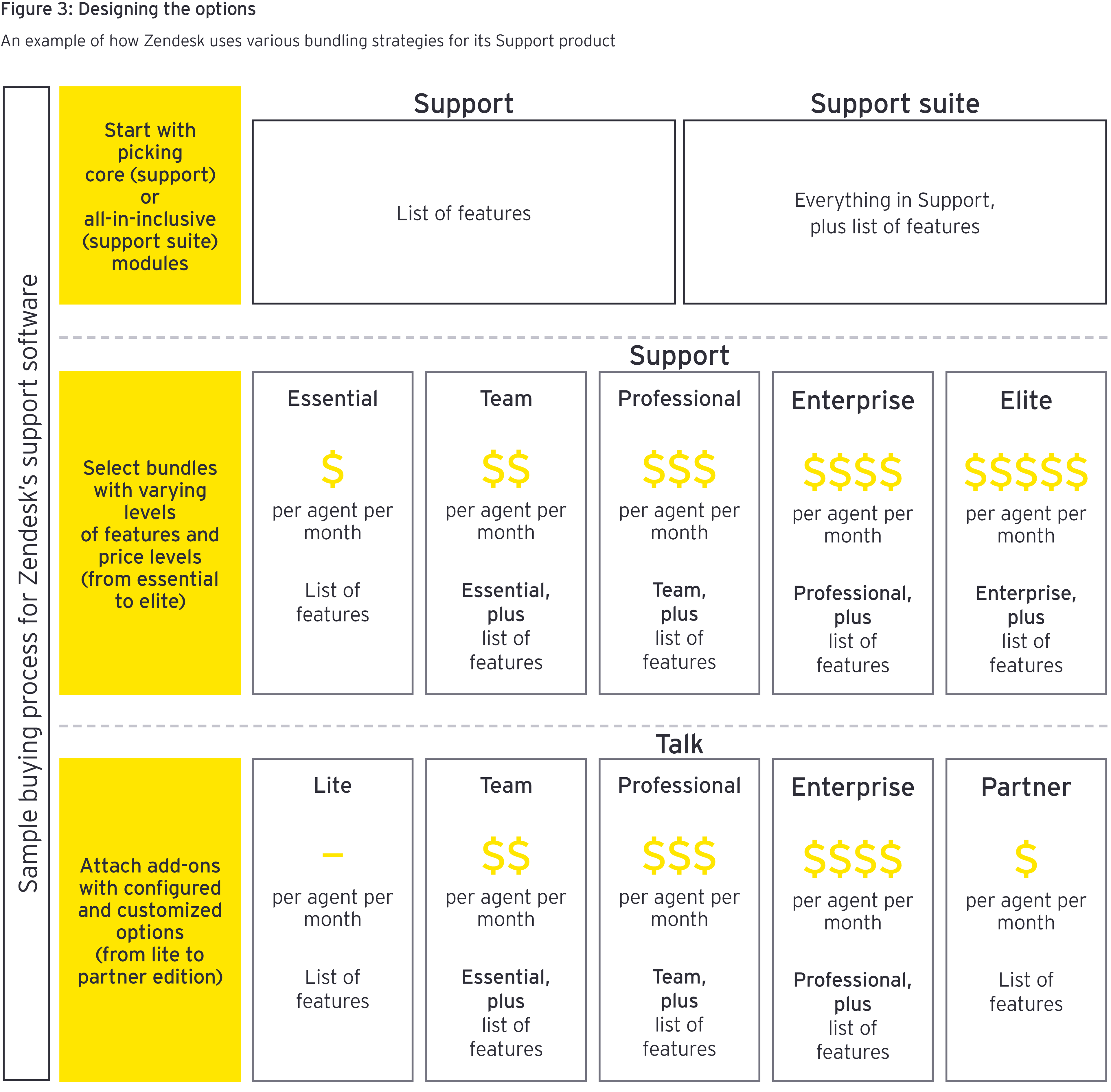We think it’s time for SaaS product and sales leaders to develop and offer packages with the same rigor as they develop their software.
A purpose-built, step-by-step approach
To help SaaS companies elevate their packaging design to a new level, we’ve applied the spirit of the agile approach to develop a packaging design framework. It supports an iterative process that leverages both visual design approaches (to visualize concepts quickly) and value management techniques (to prioritize and fine-tune designs).
As the schematic in Figure 1 shows, our framework has four main stages: sketch, wireframe, prototype and beta.

Sketch
For SaaS providers, it’s vital that packaging design aligns with the overall business and product strategy. To embed this alignment, the sketch stage involves a high-level scan of the factors that directly affect a product package, including strategic objectives, industry trends, use cases, key customer segments and product maturity.
While there are numerous packaging strategies that SaaS companies can take, our experience shows that the most successful ones consistently undertake the sketch stage iteratively to scan through the art of the possible. Even established software companies continue to go back to the drawing board and re-sketch their designs.
For example, in 2019, a few months after rolling out a new licensing plan for Dynamics 365, Microsoft2 completely changed the plan to meet specific customer needs and drive a stronger discussion on the value of the software. It adopted an à la carte menu of options aimed at serving its vast customer base more effectively.
By sketching out the options iteratively, companies can continuously review the maturity of their offerings and their alignment with customers’ buying needs. This stage also helps companies eliminate options that do not seem to work and instead focus on the ones with strong market potential.
Figure 2 shows a range of design options that could be examined during the sketch phase.

Wireframe
Once a set of viable packaging options has been identified, the wireframe stage applies a methodical approach to define the bundle parameters and design choices. In the same EY global study mentioned earlier, proper bundling of products emerges as a major challenge, with 82% of software companies citing developing clear/more compelling value propositions (e.g., bundles) as a high or medium priority for the internal sales and marketing process changes they are seeking to improve.
Addressing this concern effectively requires deep product, customer and competitive understanding. Products are broken down to features that have a distinct commercial value and then assessed by a variety of criteria, such as perceived value, relevance of the use cases and level of differentiation. As an example, Zendesk3 utilizes a mix of different packaging options to allow customers to configure a package that fits their needs. Figure 3 demonstrates a sample buying process prospective customers would go through in exploring Zendesk’s Support product offerings.
Another key area assessed during the wireframe stage is technical feasibility. Even if a packaging option seems attractive conceptually, the underlying architectural design may not be easily customized and provisioned. The design constraints have to be accounted for in this stage so the marketing and sales teams can create alternative packaging options that also meet customers’ needs. In light of this risk, the extensive evaluation of features and parameters creates the basis for an in-depth commercialization assessment in the subsequent stages.

Prototype
After undertaking a rigorous design process to land on the preferred packaging options, it is time to design the sales process journey and pilot controlled market-testing for early feedback. These activities represent the first steps in the prototype stage, with companies using the outputs to review their commercial functions and then make the necessary changes, which may be as small as a bit of tweaking or as large as redesigning the entire way the SaaS solutions are communicated, experienced and delivered.
Considering these commercial changes, the marketing team needs to rethink how the value propositions relate to customers through the new packaging options. Meanwhile, for the sales team, the first step is understanding how the packages fit into the sales process. This involves the sales and marketing teams working closely together to readjust their core activities, based on intelligence gleaned from market research and feedback from customers.
For example, the survey platform SurveyMonkey4 overhauled its pricing and packaging back in 2017. During the redesign process, the company carried out rigorous research to gain insights from both customers and prospects, while simultaneously obtaining buy-in from internal stakeholders to enable the success of the new packaging. It went on to develop product packaging options that cater to individual customers as well as enterprise clients.
Alongside optimizing pricing and packaging, another crucial step is to design a great buying experience that focuses on value. Only half of software companies in an EY research study agreed that sellers are positioned to have value-based discussions with customers. Sales teams need to be able to articulate the value for each bundle option and help customers make an informed decision.
Beta
In the beta stage, companies are pressure-testing the package-market fit in the market. During this process, leading SaaS companies pay close attention to what types of customers are being acquired, what packaging options they choose (or not) and why. For existing customers, companies leverage customer success teams to help communicate and reinforce the benefits of the new packages and, ideally, help customers migrate to new options to better meet their needs.
The cloud-based hosting platform provider HostiFi5 exemplified this stage when beta testing its product bundles based on customer purchasing patterns and usage needs. The company began by offering usage-based volume buckets of 125, 250 and 500 connected devices. After observing customer usage behavior, HostiFi found that 80% of users registered fewer than 30 devices — significantly below all its offering capacity. So, it readjusted its package capacity to align customer value with new price levels, address customer experience issues and reduce churn.
The beta phase is an iterative process that evolves with the product, customer needs and competition. SaaS companies continue to gather insights on which changes have worked well and which have fallen short. The lessons allow companies to go back to the drawing board to respond appropriately to the market feedback. As packaging design has taken an increasingly important role in the overall product design and commercialization process, it has also become an element of competitive advantage that SaaS companies should look to master.
Conclusion: four steps to prioritize now
With the rapid increase of SaaS products in the market, we have seen many clients invest heavily in building their products while directing fewer resources at how they actually package them. Yet the days of “build it and customers will come” have long gone, and getting packaging right is as important as the product itself, if not more.
For SaaS companies looking to move quickly to improve their packaging design, here are four steps to consider today:
- Examine your existing offered bundles, their adoption and their value proposition compared to the competition
- Interview customers to understand their perceptions of the value of packages and their decision-making process around buying them
- Conduct internal reviews with sales team members to understand how they leverage the current packages in the sales process and the challenges they face
- Identify opportunities to improve revenue performance by preparing a case for package-market fit
As SaaS companies focus on creating value for their customers, product packaging is the secret weapon to increase that value for priority customer segments, further enhancing their willingness to pay. We can help by sharing custom industry benchmarks and identifying specific areas of value potentials.
The authors would like to thank EY team members Omer Rub, Frank Memmo and Julia Sefler for their contribution to the article.
Summary
As Software-as-a-Service offerings have proliferated, companies have focused their attention on enhancing product features and functionalities. Product packaging – a critical component in integrating product, marketing and sales insights – has not been sufficiently backed up with market insights, often causing customer confusion over the offerings. EY has leveraged the agile product development processes and developed a Packaging Design Framework with four steps: sketch, wireframe, prototype and beta. Companies that take these steps will be able to accelerate the achievement of “package-market fit,” strengthening their value proposition and shortening the sales cycle.
